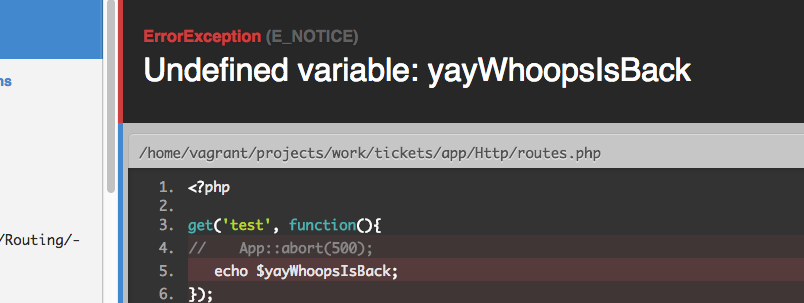Handling Errors In Laravel 5.1
Posted in Web Dev on 20th Jun 2015

I have finally gotten around to documenting what I find to be the best setup for error handling in Laravel 5.1
- Laravel 4’s Whoops error page
- HTTP Code Specific Views
- Fallback HTTP Code Views
I first started using Laravel at version 4 and got used to the detailed yet pretty to look of the ‘Whoops’ error screen. Matt Stauffer wrote a great post explaining how to get Whoops working in Laravel 5 but if you are following a long here all you need to do is composer require filp/whoops:~1.0 and I’ll explain the rest later on!
Most of our changes are in app/Exceptions/Handler.php so let’s jump in there make some changes, first adding a method then making some changes to the render() method.
First, add the following method to the Handler class.
renderHttpExceptionView() adds the ability to have a default response to any HTTP error that doesn’t have a specific view.
As given to us by Matt, it’s time to add the good old Whoops support.
/**
* Render an exception using Whoops.
*
* @param \Exception $e
* @return \Illuminate\Http\Response
*/
protected function renderExceptionWithWhoops(Exception $e)
{
$whoops = new \Whoops\Run;
$whoops->pushHandler(new \Whoops\Handler\PrettyPageHandler());
return new \Illuminate\Http\Response(
$whoops->handleException($e),
$e->getStatusCode(),
$e->getHeaders()
);
}
Now to update the render() method!
/**
* Render an exception into an HTTP response.
*
* @param \Illuminate\Http\Request $request
* @param \Exception $e
* @return \Illuminate\Http\Response
*/
public function render($request, Exception $e)
{
if ($this->isHttpException($e)) {
return $this->renderHttpExceptionView($e);
}
if (config('app.debug')) {
return $this->renderExceptionWithWhoops($e);
}
return parent::render($request, $e);
}
Finally, we just have to create resources/views/errors/default.blade.php to be used as our fallback. If an error message is set it will display it, otherwise it will default to use the description for the thrown HTTP status code.
@extends('template.master')
@section('content')
<h1>
@{{ $exception->getStatusCode() }}
</h1>
<p>
@if(!empty($exception->getMessage()))
@{{ $exception->getMessage() }}
@else
@{{ \Symfony\Component\HttpFoundation\Response::$statusTexts[$exception->getStatusCode()] }}
@endif
</p>
@endsection